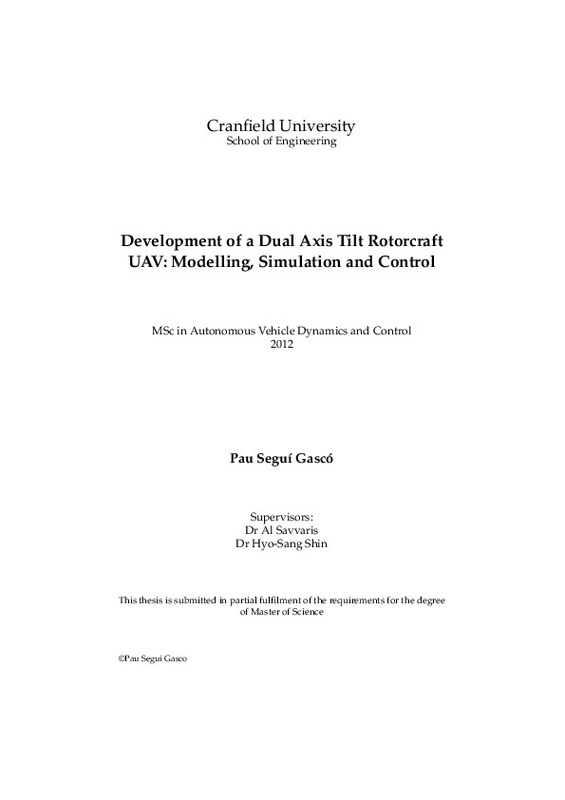JavaScript is disabled for your browser. Some features of this site may not work without it.
Buscar en RiuNet
Listar
Mi cuenta
Estadísticas
Ayuda RiuNet
Admin. UPV
Development of a Dual Axis Tilt Rotorcraft UAV: Modelling, Simulation and Control
Mostrar el registro sencillo del ítem
Ficheros en el ítem
| dc.contributor.advisor | Al Savvaris
|
es_ES |
| dc.contributor.advisor | Hyo-Sang Shin
|
es_ES |
| dc.contributor.author | Seguí Gascó, Pau
|
es_ES |
| dc.date.accessioned | 2014-06-18T07:30:28Z | |
| dc.date.available | 2014-06-18T07:30:28Z | |
| dc.date.created | 2012 | |
| dc.date.issued | 2014-06-18 | |
| dc.identifier.uri | http://hdl.handle.net/10251/38205 | |
| dc.description.abstract | This thesis stems from a project to design a novel dual axis tilt quadrotor that uses gyroscopic effects to explore an increase in the performance with respect to a conventionally actuated quadrotor. The project is developed in two theses, one by Y. Al-Rihani, [2], which develops the design and prototyping, and the present thesis which develops the mathematical model and the control system design of the new vehicle. The main contribution of this work is the development of the mathematical model of the new actuator suite and the control system design exploiting the gyroscopic features that lead to a significant improvement in performance. The mathematical model has 3 main areas. First, the development of the gyroscopic reaction moment equations for the new tilt mechanism design, taking into account the vehicle, the 2 tilting axes and the motor motion. Second, experiments are carried out to characterise the generation of the propeller forces and moments, alongside with an analysis of the efficiency of the propulsive system. Third and finally, a series of experiments are carried out to identify the dynamics the motor and the two RC servomotors, this is conducted by feeding a series of sinusoidal inputs and fitting transfer functions in the frequency domain. The control system design is composed of two main parts, the control allocator design and the control law design. The control allocator design is based around a Pseudoinverse method, to develop it, a simplification of the nonlinear dynamics is carried out to derive the control effectiveness matrix, or B matrix. The control law design is based on a SISO PD controller for each Euler angle, to develop it, firstly a simplified model of the pitch or roll dynamics is developed, then, the gains are tuned by a combination of frequency domain loop shaping and rig testing. Finally, improvements in performance of about 20% respect to a conventional actuated quadrotor are obtained with the novel actuator suite. The most important result is that, based on the obtained results, suggestions are made to improve the design of actuator suite that could lead to an order of magnitude increase in performance respect to a conventional actuator suite. Results of the first flight, rig tests and a qualitative validation of the simulation model are also presented. | es_ES |
| dc.format.extent | 177 | es_ES |
| dc.language | Inglés | es_ES |
| dc.publisher | Universitat Politècnica de València | es_ES |
| dc.rights | Reserva de todos los derechos | es_ES |
| dc.subject | Hélices | es_ES |
| dc.subject | MAV | es_ES |
| dc.subject | UAV | es_ES |
| dc.subject | Quadrotor Design | es_ES |
| dc.subject | Gyroscopic Actuation | es_ES |
| dc.subject | Overactuated | es_ES |
| dc.subject | Novel Actuator | es_ES |
| dc.subject | Propellers | es_ES |
| dc.subject | Giroscopio | es_ES |
| dc.subject | Gyroscopes | es_ES |
| dc.subject.classification | INGENIERIA AEROESPACIAL | es_ES |
| dc.subject.other | Grado en Ingeniería Aeroespacial-Grau en Enginyeria Aeroespacial | es_ES |
| dc.title | Development of a Dual Axis Tilt Rotorcraft UAV: Modelling, Simulation and Control | es_ES |
| dc.type | Proyecto/Trabajo fin de carrera/grado | es_ES |
| dc.rights.accessRights | Abierto | es_ES |
| dc.contributor.affiliation | Universitat Politècnica de València. Escuela Técnica Superior de Ingeniería del Diseño - Escola Tècnica Superior d'Enginyeria del Disseny | es_ES |
| dc.description.bibliographicCitation | Seguí Gascó, P. (2012). Development of a Dual Axis Tilt Rotorcraft UAV: Modelling, Simulation and Control. Universitat Politècnica de València. http://hdl.handle.net/10251/38205 | es_ES |
| dc.description.accrualMethod | Archivo delegado | es_ES |
Este ítem aparece en la(s) siguiente(s) colección(ones)
-
ETSID - Trabajos académicos [8900]
Escuela Técnica Superior de Ingeniería del Diseño






